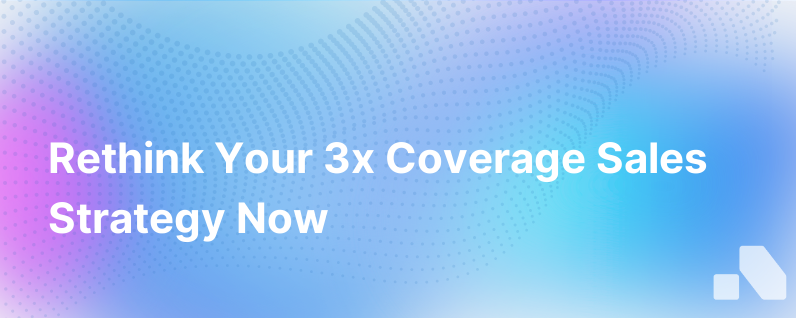
In the traditional sales playbook, the concept of a pipeline coverage ratio — often cited as the "3x coverage rule" — has been a longstanding cornerstone. This rule of thumb posits that in order to meet your sales goals, your pipeline should have three times the amount of potential deals as your target. The belief is that with a 3x pipeline coverage, you give yourself enough opportunity to absorb losses from deals that don’t close, still hitting your numbers.
However, this conventional wisdom is becoming increasingly antiquated in today's dynamic sales environment. The digital transformation of the sales process, the proliferation of data analytics, and changing buyer behaviors are all signaling that it's time to retire the old 3x pipeline coverage rule and replace it with a more nuanced approach.
Let's delve into the reasons why the 3x coverage rule is losing relevance and what modern sales strategies suggest as an alternative.
The Fallacies of the 3x Coverage Rule
-
One Size Does Not Fit All: The 3x coverage rule is based on the assumption that all sales organizations, products, and markets are the same, which is far from the truth. A startup selling a disruptive technology might face a different sales cycle and conversion rate than an established company with a mature product.
-
False Sense of Security: Following the 3x rule can lead to complacency. Reps might not put in the necessary effort to qualify leads or might overlook opportunities to nurture and potentially close more deals.
-
Neglect of Sales Velocity: Pipeline coverage ignores sales velocity — the speed at which deals move through your pipeline and convert into revenue. A healthy pipeline isn't just about quantity; it's about momentum and progression as well.
-
Quality Over Quantity: The 3x rule emphasizes the number of deals rather than the quality. Focusing on higher-quality leads can result in a better use of time and resources, potentially leading to a higher conversion rate. Spending the same time nurturing three qualified leads might be more beneficial than juggling nine less qualified opportunities.
-
Data-Driven Customization: In today's data-rich environment, sales strategies should be informed by real-time analytics. The availability of sales intelligence tools allows sales teams to forecast more accurately based on historical conversion rates, deal sizes, and sales activities.
A Modern Take on Pipeline Management
The evolution of sales strategies calls for a move away from rigid rules towards a more dynamic, data-informed approach. Here's what that looks like:
-
Customize Your Coverage Ratios: Establish ratios based on historical data and predictive analytics. Analyze past performance to determine your true conversion rate and adjust your coverage ratio accordingly.
-
Qualify Rigorously: Implement a robust qualification process to ensure that only the most promising opportunities enter your pipeline. Sales methodologies like MEDDIC or BANT can streamline this process by setting qualifying criteria.
-
Leverage Sales Technology: Use CRM and AI-driven tools to gain deeper insights into which deals are more likely to close. For example, Aomni, an AI platform for B2B sales, provides real-time account research and competitive insights that can significantly optimize your sales efforts.
-
Focus on Pipeline Health: Evaluate pipeline health indicators like deal stage duration, average deal size, and win rates. Develop strategies to advance stagnant deals and prioritize opportunities with the highest likelihood to close.
-
Implement Account-Based Sales Motion: Shift from a numbers-driven approach to an account-based strategy. This focuses your resources on a smaller number of high-value accounts with personalized engagement.
Actionable Sales Strategies for Better Pipeline Health
Adopting a more sophisticated sales strategy involves a number of practical actions:
-
Pipeline Analysis: Regular, rigorous analysis of your pipeline can help identify bottlenecks, potential churn, and sales velocity. It allows for a timely re-calibration of strategies.
-
Prospect Segmentation: Prospects should not be treated equally. Segment them based on potential deal size, readiness to buy, and strategic fit. Concentrate efforts where they can make the most impact.
-
Sales & Marketing Alignment: Ensuring that marketing and sales efforts are aligned can lead to a more efficient lead generation and nurturing process, which in turn can contribute to a healthier pipeline.
-
Training and Enablement: Equip your sales team with the knowledge and tools they need to identify high-quality leads and effectively nurture them through the sales funnel. This might include training on advanced questioning techniques, persuasive selling, and use of sales intelligence tools.
Embrace the New Sales Coverage Paradigm
The legacy 3x coverage rule no longer caters effectively to the nuances of modern B2B selling, where data-driven insights and tactical flexibility reign supreme. The imperative for sales leaders is clear: Retire outdated heuristics and embrace a more sophisticated, strategic, and customized approach to pipeline management.
Amtssprache the age of AI and advanced analytics, platforms like Aomni enable sales teams to transcend traditional rules and adapt to the complexities of contemporary sales environments. Tools that provide real-time insights into account behavior and competitive landscapes have made it possible to achieve a level of precision in sales operations that was previously unattainable.
Conclusion
The shift away from the 3x pipeline coverage rule isn't just about rejecting old norms but about embracing a strategic framework tailored to your unique business context. It's about quality, specificity, and the effective utilization of advanced tools and analytics that fit the nature of today's sales landscape. As the selling environment becomes more complex, having the right insights, priorities, and tools — such as those offered by Aomni — can be the key to achieving and sustaining competitive advantage.